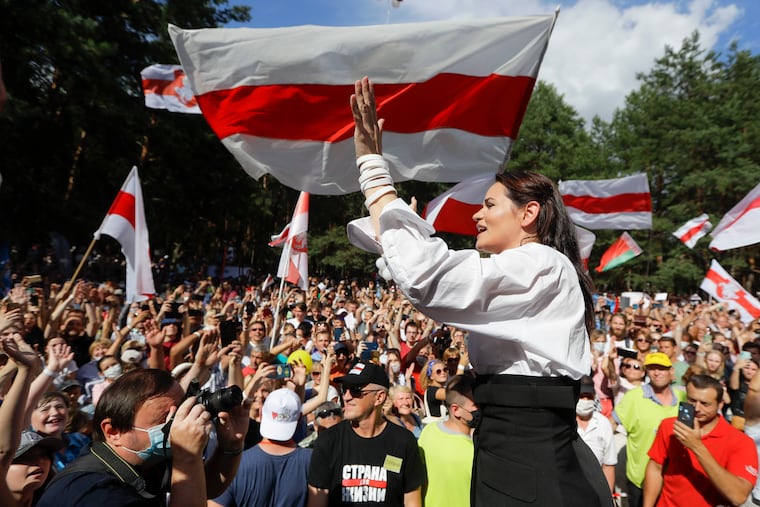The Belarus election crisis has lessons for Trump’s fragile America | Trudy Rubin
Strongman Lukashenko rigged the election in Belarus in ways Trump can only dream of.

Pay attention to the protests by hundreds of thousands of Belarusians who are demonstrating against a presidential election rigged by strongman Alexander Lukashenko. They should inspire Americans — for reasons that go beyond their bravery against violent secret police.
The Belarus crisis is a cautionary tale as we watch a U.S. president lay the groundwork to reject election results should he lose in November. He clearly does not want to leave the White House in January 2021, no matter the public’s will.
True, Lukashenko, Europe’s last dictator, has far more coercive tools than Donald Trump. The regime has arrested 7,000 demonstrators, and beat and tortured many of them while jailing leading opposition figures and forcing others to flee abroad.
Yet, by his actions, Trump indicates he’d like to do a Lukashenko by other means.
The president has been trying hard to undermine trust in the November ballot. He wants to repress the opposition vote by spreading lies about mail-in ballots and gutting the U.S. Postal Service. He has cast doubt on whether he would accept the results if he is the loser. And we’ve seen his open admiration for autocrats around the world.
The struggle in Belarus is a reminder of the price to be paid in countries that lack our (surviving) checks and balances. And the need to thwart Trump’s efforts to pull a Lukashenko here.
Lukashenko has ruled for 26 years over a small (population 9.5 million) post-Soviet state at a geopolitical crossroads, bordered by Russia, the Baltic states, Poland, and Ukraine. Yet, despite the huge, obvious differences between Belarus and the U.S., there are some remarkably similar themes and some clear warning signals from Minsk.
The popular revolt in the former emerged in part from Lukashenko’s failure to deal with COVID-19 — he ignored it.
Public revulsion mounted over his blatant lies about election numbers. Leading opposition figure Valery Tsepkalo, a former ambassador to the United States who has fled with his family to Poland, claims Lukashenko simply cooked the figures.
The autocrat reacted when it became clear that opposition leader Sviatlana Tikhanovskaya was winning, claiming he had 80% of the vote and she had 10%. This 37-year-old former English teacher had stepped in after her candidate husband was jailed. Disdainful of women, Lukashenko claimed she would “collapse” in office.
» READ MORE: Putin, facing resistance, needs a Trump win more than ever | Trudy Rubin
Juggling a cell phone as he made his way to Warsaw, Tsepkalo described the rigging process to a webinar hosted by the Center for Strategic and International Studies: “I collected 220,000 signatures to run, although only 100,000 were necessary, and another candidate collected 400,000, but they were thrown in the garbage. Lukashenko simply gave instructions to the chairman of the central election commission.”
Fortunately, White House lies have not reached that point — yet.
Lukashenko has also tried to paint peaceful protesters as violent, to justify his violent crackdown. But the graphic injuries to some released protesters were so awful, they brought more demonstrators to the streets.
And he has tried to scare the Belarus public with racist claims that NATO is massing troops on their border and will send in “black-skinned ... blond-headed invaders.” His claims about a pending NATO invasion — totally false — are meant to gain support from Vladimir Putin, with whom he has a dicey relationship, but has called twice in the past week.
In actual fact, demonstrators in Belarus have been careful to focus only on domestic issues. They have carried only the red and white Belarusian flag, not any U.S. or EU banners, so as not to disturb Putin or give him cause to accuse them of making a pro-West “color revolution” like that of Ukraine in 2014.
Yet it looks as if the Belarus strongman is now hoping Putin will save him. Experts on Belarus doubt the Russian leader would send in troops. However, they think he might try to force Lukashenko to step down while ensuring a Putin-friendly alternative wins a new election. But Lukashenko says: “Until you kill me, there will be no other elections.”
So we have a racist, misogynistic despot who rigs an election and refuses to step down, but may need Putin to save him from a public that rejects him. A public that now includes protesting factory workers. A public that includes state-owned television workers who are rebelling.
That is Lukashenko’s crisis.
Back in the United States, Trump, despite an effort to create his own mini-militia out of Homeland Security forces, still has no secret police. Courts still function, and the press is still free, although undercut by online conspiracy theorists.
Yet, the public should have no illusions about Trump’s autocrat-envy. Or his willingness to create election chaos and wholly misrepresent the vote. Or his indifference to Russian meddling.
So congressional and media pushback against Trump’s efforts to cripple the Postal Service and undercut mail-in votes is essential.
We are not Belarus, which is why Trump cannot do a full Lukashenko. But from now through January, those who care about democracy must guard against White House efforts to rig the 2020 election, Trump-style.